
The savanna hawk is a large raptor found in open savanna and swamp edges. It was formerly placed in the genus Heterospizias. It breeds from Panama and Trinidad south to Bolivia, Uruguay and central Argentina.

The scrub greenlet or scrub vireo is a small passerine bird in the vireo family. It breeds in Costa Rica, Panama, Colombia, Venezuela and Tobago. They can be found in the southernmost part of Central America and northern South America, which can be defined as extending from Venezuela to Colombia.

The white-throated spadebill is a tiny passerine bird in the tyrant flycatcher family. It lives in the tropical Americas.

The slaty-capped flycatcher is a small passerine bird in the tyrant flycatcher family. It is found in northern Bolivia to Costa Rica and in Trinidad.

The black-whiskered vireo is a small passerine bird, which breeds in southern Florida, USA, and the West Indies as far south as the offshore islands of Venezuela. It is a partial migrant, with northern birds wintering from the Greater Antilles to northern South America. This species has occurred as a rare vagrant to Costa Rica.
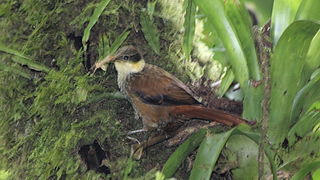
The buffy tuftedcheek or Lawrence's tuftedcheek is a passerine bird in the ovenbird family, which breeds in the tropical New World in Costa Rica and western Panama. It is sometimes considered conspecific with the streaked tuftedcheek, P. boissonneautii, of South America.

The black-cheeked warbler is a New World warbler, resident breeding bird endemic to the Talamancan montane forests of Costa Rica and western Panama.
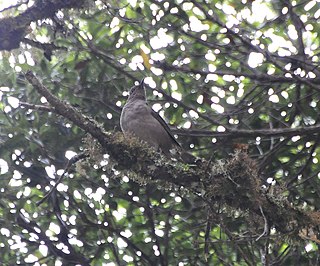
The mountain thrush is a large thrush which is found in Central America. It was formerly known as the mountain robin. Some authorities refer to it as the American mountain thrush to differentiate it from the Abyssinian thrush, known in their taxonomy as the African mountain thrush.

The brown-capped vireo is a small passerine bird. It breeds in highlands from southern Mexico south to northwestern Bolivia. It is sometimes considered to be conspecific with the similar warbling vireo.

The yellow-winged vireo is a small passerine bird. It is endemic to the highlands of Costa Rica and western Panama.

The common chlorospingus, also referred to as common bush tanager, is a small passerine bird. It is a resident breeder in the highlands from central Mexico south to Bolivia and northwest Argentina. C. flavopectus in the loose sense is a notorious cryptic species complex, and several of the up to 25 subspecies recognized in recent times are likely to be distinct species. Some populations in fact appear to be more distinct than several other members of Chlorospingus.
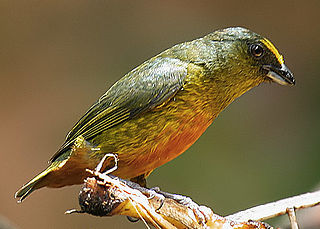
The olive-backed euphonia is a small passerine bird in the finch family. It is a resident breeder in the Caribbean lowlands and foothills from southern Mexico to western Panama.

The barred becard is a small passerine bird which is a resident breeding species in highlands from Costa Rica to northwestern Ecuador and northern Bolivia. It has traditionally been placed in Cotingidae or Tyrannidae, but evidence strongly suggests it belongs in Tityridae, where it is now placed by the South American Classification Committee.
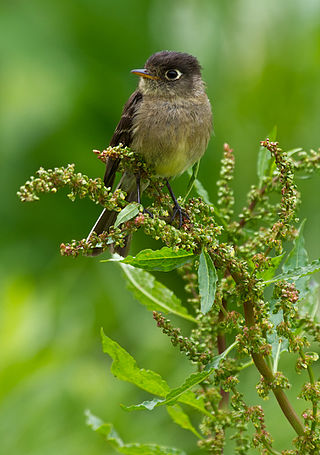
The black-capped flycatcher is a very small passerine bird in the tyrant flycatcher family. It is endemic to the highlands of Costa Rica and western Panama.

The black-capped pygmy tyrant is the smallest passerine bird in its range, though larger than its cousin, the short-tailed pygmy tyrant. This tyrant flycatcher occurs from Costa Rica to north-western Ecuador.

The white-eared ground sparrow is a large American sparrow which occurs locally in Middle America, mostly in foothills, from southern Mexico and Guatemala to northern Costa Rica.
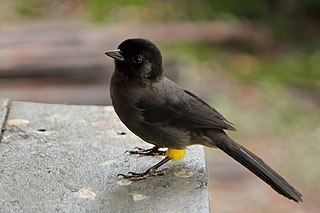
The yellow-thighed brushfinch is a passerine bird which is endemic to the highlands of Costa Rica and western Panama. Despite its name, it is not a true finch, but rather a member of the family Passerellidae, which also includes American sparrows, juncos and towhees.

The black-striped sparrow is a passerine bird found from eastern Honduras to western Ecuador, northern Brazil, and Venezuela.
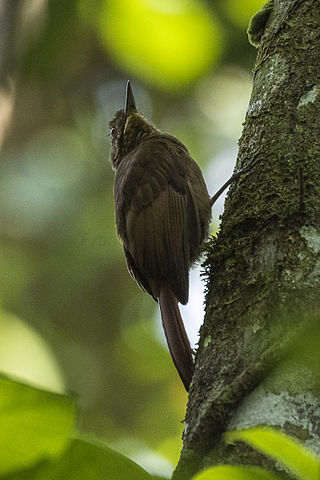
The tawny-winged woodcreeper is a passerine bird in subfamily Dendrocolaptinae of the ovenbird family Furnariidae. It is found in Belize, Costa Rica, Guatemala, Honduras, Mexico, Nicaragua, and Panama.

Cabanis' ground sparrow or Costa Rican ground sparrow, is a New World sparrow. It previously was considered a subspecies of the Prevost's ground sparrow.























